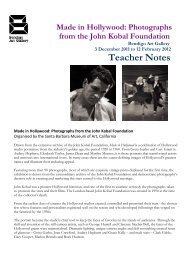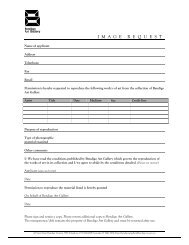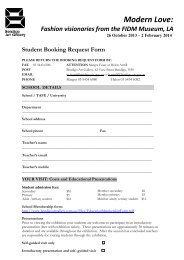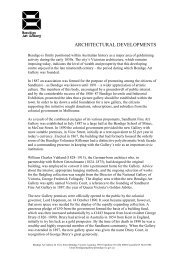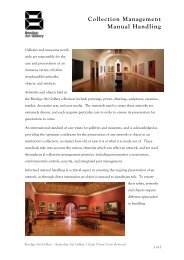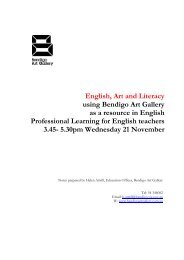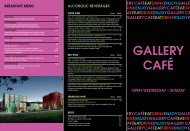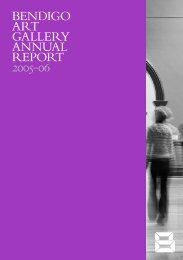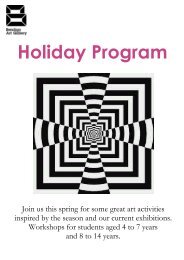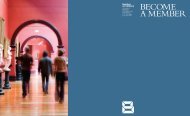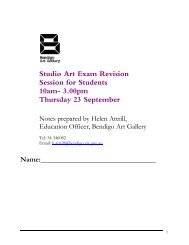Michael O'Connell: The Lost Modernist - Bendigo Art Gallery
Michael O'Connell: The Lost Modernist - Bendigo Art Gallery
Michael O'Connell: The Lost Modernist - Bendigo Art Gallery
Create successful ePaper yourself
Turn your PDF publications into a flip-book with our unique Google optimized e-Paper software.
<strong>Michael</strong> O’Connell: <strong>The</strong> <strong>Lost</strong> <strong>Modernist</strong><br />
A <strong>Bendigo</strong> <strong>Art</strong> <strong>Gallery</strong> exhibition<br />
26 November 2011 – 26 February 2012<br />
Teacher Notes<br />
<strong>Michael</strong> O’Connell, Pandemonium, frieze (detail) c1930, linocut on silk, National <strong>Gallery</strong> of Australia, Purchased 1982.<br />
This exhibition examines the work of British/Australian textile artist <strong>Michael</strong> O’Connell. Born in Cumbria in 1898<br />
O’Connell moved to Australia in 1920. Over the following 17 years he became a critical member of the burgeoning<br />
<strong>Modernist</strong> movement in Melbourne.<br />
O’Connell, a member of the <strong>Art</strong>s and Crafts Society of Melbourne, made an enormous contribution to the development<br />
of Modernism in Australia through his innovative and dynamic textiles. Furthermore on his return to the UK in 1937,<br />
O’Connell became a key figure in contemporary textile design, working with renowned textile manufacturer Heals.<br />
O’Connell was also commissioned to produce the celebrated Festival of Britain wall hangings in 1951, which are now in<br />
the collection of the Museum of English Rural Life, Reading.<br />
<strong>The</strong> exhibition has been co-curated by Professor Harriet Edquist, Director, Design Archives RMIT University and<br />
Tansy Curtin, Curator, <strong>Bendigo</strong> <strong>Art</strong> <strong>Gallery</strong>. A book on the life and work of O’Connell by Edquist will be published<br />
concurrently.<br />
<strong>Michael</strong> William <strong>O'Connell</strong> (1898–1976)<br />
by John McPhee<br />
<strong>Michael</strong> William <strong>O'Connell</strong> (1898-1976), artist, was born on 7 August 1898 in England, son of Patrick <strong>O'Connell</strong>, inland<br />
revenue officer, and his wife Mary Cecilia, née McNamara, headmistress of a Roman Catholic school for girls. He was a<br />
descendant of the Irish patriot Daniel <strong>O'Connell</strong>. He began to train as a priest, a vocation he abandoned. Enlisting in<br />
1916, he served in France, where he was taken prisoner, and at this time began to make sketches, his first artistic efforts.<br />
<strong>O'Connell</strong> arrived in Australia in 1920, intending to go on the land, but after two days at the Wagga Wagga Agricultural<br />
Farm School, New South Wales, tried various occupations, including photography, while attempting to make a living<br />
from art. Exhibitions of his water-colours were held at the Athenaeum <strong>Gallery</strong> in Melbourne in 1921 and 1922. Settling<br />
in Melbourne, he worked at landscape gardening and the construction of concrete garden ornaments, which he<br />
exhibited with the <strong>Art</strong>s and Crafts Society of Victoria of which he was an active member and councillor.
In the early 1920s he built his own house, Barbizon, at Beaumaris. <strong>The</strong> large open-plan cruciform house, constructed<br />
with <strong>O'Connell</strong>'s home-made concrete blocks, was destroyed by a bushfire in 1947. About 1924 he met London-born<br />
Ella Moody, née Evans-Vaughan (1900-1981), an embroiderer and printmaker who was secretary of the <strong>Art</strong>s and Crafts<br />
Society of Victoria. In 1929 they visited Britain and Italy where <strong>O'Connell</strong> studied old masonry. After their return, late<br />
that year, they began to collaborate in the production of hand-printed textiles, using novel Australian-inspired designs.<br />
<strong>Michael</strong> learned the techniques of cutting and printing with linoleum blocks from Ella and throughout their partnership<br />
she did much of the work on all levels of design and production. After her divorce in February they married on 4 April<br />
1931 in Melbourne, and visited England in 1932-33. <strong>O'Connell</strong> was then associated with Cynthia Reed and Frederick<br />
Ward in an interior decorating business in Melbourne. Through writing and radio talks he became a leading advocate of<br />
simple modern design for furnishings and interiors.<br />
In March 1937 the <strong>O'Connell</strong>s returned to England and purchased land at Perry Green, Much Hadham, Hertfordshire,<br />
where they built their house, <strong>The</strong> Chase. <strong>The</strong>y continued to produce printed textiles identified as Mael Fabrics, a<br />
combination of their names and a recognition of Ella's contribution. Soon after the birth of their son in 1943, the<br />
couple separated.<br />
<strong>O'Connell</strong>'s fabric designs were printed by the Edinburgh Weavers and London department stores, Heal & Sons and<br />
Harrods. He also made large fabric hangings, such as the backcloth for St Martin's Church, Manchester, which were<br />
widely exhibited.<br />
<strong>O'Connell</strong> died on 9 December 1976 at <strong>The</strong> Chase. His textiles represent a unique aspect of the decorative arts in<br />
Australia. His work influenced and inspired both amateurs and professionals in the field of fabric-printing, and in<br />
England was central to the modernist revival of the British textile industry. He is represented in the National <strong>Gallery</strong> of<br />
Australia, Canberra, and the Museum of Applied <strong>Art</strong>s and Sciences, Sydney.<br />
1. <strong>Michael</strong> O’Connell, Hanging (curtains) c1930s, linen, dye, ink-bias binding, cotton, linocut hand-block printed, National <strong>Gallery</strong> of Victoria, Gift of Mr<br />
Richard Derham 1988.<br />
2. <strong>Michael</strong> O’Connell, Wild Women (curtain length) c1931, linocut on silk, National <strong>Gallery</strong> of Australia, Purchased 1980.<br />
This exhibition is indemnified by the Victorian<br />
Government through <strong>Art</strong>s Victoria



